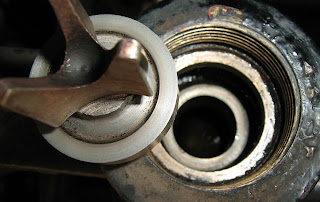The rotation action is backwards and forwards in a two steps forward, one step back arrangement with the two rubbing surfaces never being allowed to stay in the same place for long. Otherwise the surfaces could stray from being flat and a good seal would only take place when the valve and seat had a particular position relative to each other. This would be clearly undesirable so hence the continual back and forth rotational movement.
 |
| Inlet Valve being reground. |
Inlet Valve
I did the inlet valve first and the result is below (apologies for slight lack of focus).
 |
| Inlet valve after the regrind Deposits on the valve have gone and the marks on the seat are lessened |
 |
| Cap viewed from the side/below |
 |
| Cap viewed from above |
The original cap seems to have been made from gunmetal; however, a 1.5 inch diameter piece of brass rod has been machined for the new one.
 |
| Old and new |
Needless to say, the outer cover which holds the new cap in place should only be delicately 'nipped' tight to avoid further destruction!
 |
| New valve cap installed |
The outlet valve was reground in a similar manner to the inlet valve.
 |
| Valve deposits removed compared to before |
 |
| Seat deposits reduced |




























